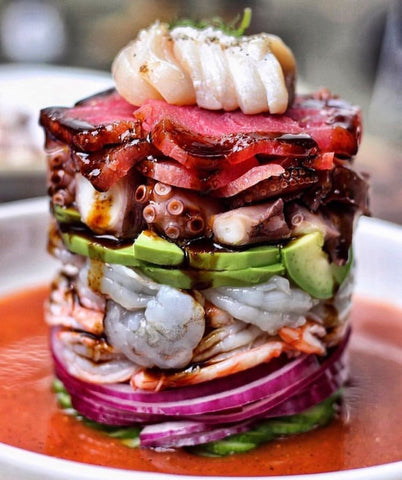But not everyone holds all pozoles on the same pedestal. People—and even entire regions, cities, and towns—tend to have deep loyalties to only one camp: red (pozole rojo), green (pozole verde), or white (pozole blanco).
From the day I could hold a spoon, I’ve been partial to rojo. Bold, bright, rich and festive, I love it not only because I grew up eating it, but because it speaks to me of celebration. (My mother used to make pozole rojo for every and any event, including my wedding.) So you can imagine how shocked my family was when I let a second type of pozole deep into my heart: the velvety, sleek, and nurturing pozole verde.
Of course, at their core, most pozoles are the same. They start with the earthy, sink-your-teeth-in depth of cooked hominy along with its thickened broth. Known in Mexico as maíz cacahuacintle or maíz pozolero (and sometimes known in the U.S. as simply “pozole”), the hominy is cooked just until the tops merely open, blooming to reveal its signature chewy texture. That base is typically mixed with pork or chicken, vegetables, herbs, and aromatics. If you stop here (and plenty of cooks do), you’ve got pozole blanco—all you have to do is garnish it with the usual suspects of dried oregano, radishes, cilantro, onion, one or another kind of crushed dried chile, and a squeeze of fresh lime. Eat it with a crispy tostada and you’ve got a meal.
When a blanco pozole goes rojo, it’s thanks to a red seasoning sauce that’s added near the end of the process. This sauce is typically made of dried chiles such as anchos, guajillos, or colorados; some seasonings and spices; and, sometimes, tomatoes. To take a pozole to verde territory, a green seasoning sauce is added. The most famous versions come from the state of Guerrero on the Pacific coast, and include green ingredients such as poblano, jalapeño and/or serrano chiles; fresh lettuce (sometimes); and radish leaves. Instead of using tomatoes, bright green and tart tomatillos are used; sometimes other green ingredients are added, like pumpkin seeds, which add a velvety finish and nutty taste.
I’ve fallen for pozole verde of all kinds: chicken, pork, even a regional variation made with beans. A vegetarian pozole, the base is a generous pile of mushrooms (any kind works) that are cooked until their juices release and they start to brown. A green seasoning sauce made from tomatillos, poblanos, and an optional serrano is added and cooked to thicken, then the hominy and broth get mixed in. Finally, like all pozoles, it is garnished to taste—I like pungent radishes, fragrant oregano, crunchy onion, tender leaves of cilantro, and a healthy squeeze of lime juice. Chased with bites of crunchy corn tostadas and it’s a pozole that even a rojo devotee can love.
This vegetarian pozole relies on meaty mushrooms and, of course, toothsome hominy to become a filling, soul-nourishing meal-in-a-bowl. As with all pozoles, the garnishes are the thing: Top this one with pungent radishes, fragrant oregano, crunchy onion, and tender leaves of cilantro, and squeeze in as much lime juice as you please.
Ingredients
Makes 6 servings
-
2 340gr cans of tomatillos
-
2 garlic cloves
-
3 poblano or green bell pepper chiles, halved, seeds removed, coarsely chopped
-
1 serrano chile, coarsely chopped (optional)
-
1 cup salted, roasted pumpkin seeds (pepitas)
-
1 cup chopped cilantro, plus more for serving
-
1 cup chopped parsley, plus more for serving
-
3 Tbsp. chopped white onion, plus more for serving
-
6 cups low-sodium vegetable broth, divided
-
1½ tsp. kosher salt, divided, plus more
-
2 Tbsp. vegetable oil
-
2 lb. mixed mushrooms (such as white button and crimini), thinly sliced
-
½ tsp. freshly ground black pepper
-
1 860gr can hominy, drained
-
2–3 radishes, trimmed, halved, thinly sliced crosswise
-
Lime wedges and dried Mexican oregano (for serving)
-
Tostadas (for serving)
Step 1
Combine tomatillos and garlic in a medium saucepan, pour in water to cover, and bring to a boil. Reduce heat and simmer until tomatillos are mushy and soft but not falling apart, about 10 minutes.
Step 2
Transfer tomatillos, garlic, and 1 cup cooking liquid to a blender. Add poblano chiles, serrano chile (if using), pumpkin seeds, 1 cup cilantro, 1 cup parsley, 3 Tbsp. white onion, 1 cup broth, and 1 tsp. salt. Purée until smooth; set aside. (Work in batches if needed, or blend directly in saucepan with an immersion blender if you have one.)
Step 3
Heat oil in a large pot over high. Once it’s hot, but not smoking, add mushrooms and sprinkle pepper and remaining ½ tsp. salt over; toss to combine. Cook, stirring occasionally, until mushrooms release all of their liquid and it evaporates and edges of mushrooms begin to brown, 8–10 minutes.
Step 4
Pour tomatillo purée into pot, reduce heat to medium, and cook, stirring occasionally, until purée thickens and darkens in color, about 10 minutes.
Step 5
Add hominy and remaining 5 cups broth to pot, stir to combine, and cook until flavors have come together, 12–15 minutes. Taste and season pozole with more salt if needed.
Step 6
Serve pozole verde with radishes, lime wedges, dried oregano, more white onion, cilantro, and parsley alongside so guests can top their bowl as desired.
Step 7
Cook’s Note: To cook dried hominy: Place 1 cup hominy in a small bowl and pour in water to cover. Let soak 2–12 hours. Drain, place in a pot, and cover with a generous amount of water. Bring to a boil, then reduce heat and partially cover. Simmer until top of each hominy blooms and opens up from the top, 2½–3 hours. Season with kosher salt.
From Epicurous - Pati Jinich

















